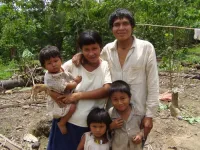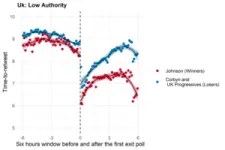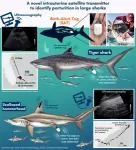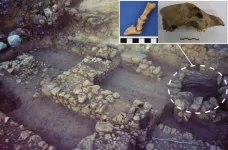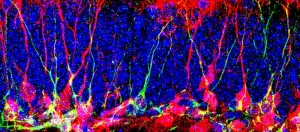(Press-News.org) A team of global experts has discovered new signals of natural selection in humans.
Led by UC Santa Barbara Tsimane Health and Life History Project co-director Michael Gurven, the team studied two populations living in the Bolivian Amazon rainforest — the Tsimane and the Moseten. Previous studies show that these tropical populations are exposed to many parasites and a variety of pathogens; at the same time, the Tsimane rarely suffer from cardiovascular diseases and dementia. This new research suggests that the Tsimane genome has undergone selection for traits associated with immunity and metabolism.
The work adds context on the evolution and specialization of humans around the world, moving beyond a few well-known cases. For example, descendants of Europeans, some Africans, and those of the Middle East can digest lactose into adulthood, which maintains their ability to drink milk past puberty in these populations. The study is published in the Proceedings of the National Academy of Sciences.
According to lead author and Vanderbilt University professor Amanda Lea, “despite the great interest in understanding DNA variants that differ adaptively between populations, it is still difficult to identify and characterize these variants. However, the work is important because we can discover parts of the genome that vary and are important from both evolutionary and biomedical perspectives."
An especially unique part of this research is its origins: a collaboration between the Tsimane Health and Life History Project, and the Tsimane and Moseten communities. For 20 years, the project has included joint work between anthropologists, doctors, Indigenous leaders, community members and local institutions to build a picture of their health and to improve it. Such trusted partnerships are vital to navigating the ethical landscape around studying DNA in Indigenous populations. In fact, the team has developed a new system for sharing data, one that balances the goals of open science with the need for fairness, equity and Indigenous data sovereignty. It’s a way forward for Western science in its efforts to address issues such as lack of diversity in human genome work, and the historical reticence and mistrust many Indigenous populations have with participating in genetic and biomedical studies.
“Most of the research connecting DNA mutations to health has been in European or North American populations,” Gurven said of the importance of working with the aborigines of lowland South America. “Groups like the Tsimane have a different history living in a different environment. It is logical that genetic variants unique to the Tsimane do not exist in the most frequently studied populations. Exploring the unique variants and their relationship to health consequences is something we are doing and we are very happy about that.”
Using a variety of techniques, they found 21 regions in the genome that swept through the Tsimane population, including key players that affect immune defenses against micro- and macro-organisms, and how fats are metabolized by our cells. They found that immunity-related traits were affected by selection occuring at multiple genetic regions simultaneously (called polygenic selection). They also showed that many genes expressed in blood were related to immune function, and that regulatory genes affected levels of white blood cell counts, blood cholesterol and blood sugar.
One of the surprising results for the researchers was to find , there seems to be a beneficial variants that affect the way in which the Tsimane use energy. Previous research suggested that deleterious alleles in U.S. or European populations, including Apolipoprotein-E4 that increases the risk for Alzheimer’s disease, have a muted, or even a positive effect in an environment with many infectious agents and limited energy such as where the Tsimane live. Studying genetic variants that affect immunity, infection risk and cardiometabolic health can greatly advance our understanding of why harmful alleles still exist today.
This project was carried out with the Tsimane, one of more than 35 Indigenous groups in Bolivia. The Tsimane population includes approximately 17,000 people in 90 villages. Blood samples were collected from more than 1,000 people between 2006 and 2015 by the Tsimane Health and Life History Project. DNA and information on single nucleotide polymorphisms were gathered from the blood samples, and the team identified areas of the genome that underwent positive selection. The researchers used statistical programs and online databases to identify correlations in genetic areas related to immunity. The group also investigated relationships between genotypes (genes) and phenotypes (how those genes are expressed). In the future, the team plans to explore other ways in which Tsimane genes may differ from those of other populations, such as Europeans. It will also build a rich reference of the Tsimane people using other biomedical techniques, including transcriptomics, metabolomics and microbiome, to connect genetics with health.
END
Special Selection
Researchers uncover evolutionary selection for traits associated with immunity and metabolism in Tsimane and Moseten genomes
2023-03-01
ELSE PRESS RELEASES FROM THIS DATE:
Bronze Age well contents reveal the history of animal resources in Mycenae, Greece
2023-03-01
A large Bronze Age debris deposit in Mycenae, Greece provides important data for understanding the history of animal resources at the site, according to a study published March 1, 2023 in the open-access journal PLOS ONE by Jacqueline Meier of the University of North Florida and colleagues.
Animals were an important source of subsistence and symbolism at the Late Bronze Age site of Mycenae in Greece, as evidenced by their depictions in art and architecture, but more research is needed on the animals ...
What distinguishes fans from celebrity stalkers?
2023-03-01
A survey study of U.S. college students provides new insights into factors associated with the tendency to engage in celebrity stalking behaviors. Maria Wong (Idaho State University, U.S.), Lynn McCutcheon (North American Journal of Psychology, U.S.), Joshua Rodefer (Mercer University, U.S.) and Kenneth Carter (Emory University, U.S.) present these findings in the open-access journal PLOS ONE on March 1, 2023.
Celebrities around the world deal with the threat of unwanted and threatening or intimidating attention or harassment—commonly known as stalking. A growing body of research is exploring and identifying factors that are associated ...
Pregnant Shark birth tracking technology provides key data for species protection
2023-03-01
Most people find sharks threatening. Who doesn’t have an image in their mind of a menacing shark fin racing through the ocean in search of its next meal?
But it is the shark that is threatened.
According to Defenders of Wildlife, a national nonprofit dedicated to protecting imperiled species, 75% of shark species are threatened with extinction and up to 73 million sharks are being killed each year for their fins.
Habitats that were once secure places for sharks to give birth have also been affected. And the fact that sharks have long gestation periods, giving birth ...
Scientists discover how to prevent death of nerve cells in most common forms of MND and dementia
2023-03-01
**Strictly embargoed until 19:00 (GMT) Wednesday 1 March 2023**
Scientists discover how to prevent death of nerve cells in most common forms of MND and dementia
Researchers from the University of Sheffield’s Institute of Translational Neuroscience have discovered how to prevent the death of nerve cells and protect nerves from neurodegeneration in the most common forms of MND and frontotemporal dementia
The researchers used a peptide, a small assembly of amino acids or protein bricks, with a cell-penetrating ...
Obstacles for breast cancer prevention in high-risk Black women
2023-03-01
Black women at high risk of breast cancer face a variety of obstacles that may keep them from care that could prevent cancer and increase the chances they’ll survive if they develop the disease, new research has found.
A study from researchers at The Ohio State University provides insights into the factors that contribute to racial disparities in use of preventive measures, including genetic testing, prophylactic mastectomies and medication to thwart breast cancer.
In the new study, which appears today (March 1, 2023) in the journal PLOS ONE, the ...
Waxing and waning of environment influences hominin dispersals across ancient Iran
2023-03-01
A world-first model of paleoclimate and hydrology in Iran has highlighted favourable routes for Neanderthals and modern human expansions eastwards into Asia.
Published in PLOS ONE, the findings reveal for the first time that multiple humid periods in ancient Iran led to the expansions of human populations, opening dispersal route across the region, and the possible interactions of species such as Neanderthals and our own Homo sapiens.
Professor Michael Petraglia, a key researcher in the study, said historic humid ...
Vitamin B5 could help improve red blood cell production in people with Myelodysplastic syndromes
2023-03-01
Queen Mary University of London and Francis Crick Institute press release
Under strict embargo: 19:00hrs GMT Wednesday March 1, 2023
Peer reviewed
Experimental study
Cells
Vitamin B5 could help improve red blood cell production in people with Myelodysplastic syndromes
Scientists from Barts Cancer Institute at Queen Mary University of London and the Francis Crick Institute, have uncovered why patients with a rare type of blood cancer suffer from ineffective red blood cell production, and how vitamin B5 could be combined with existing drugs to improve outcomes.
Myelodysplastic syndromes (MDS) are a type of blood cancer characterised ...
How to generate new neurons in the brain
2023-03-01
Some areas of the adult brain contain quiescent, or dormant, neural stem cells that can potentially be reactivated to form new neurons. However, the transition from quiescence to proliferation is still poorly understood. A team led by scientists from the Universities of Geneva (UNIGE) and Lausanne (UNIL) has discovered the importance of cell metabolism in this process and identified how to wake up these neural stem cells and reactivate them. Biologists succeeded in increasing the number of new neurons in the brain of adult and ...
Stress gene dysregulation found in kids after injury from abuse vs. accident
2023-03-01
Epigenetic changes in the regulation of a key gene in the body’s stress response system were detected in babies and young children with abusive injuries, as opposed to accidental, according to a pilot study published in the journal Pediatric Research.
The epigenome influences levels of gene expression in response to the physical, social and emotional environment, without altering the DNA sequence. Multiple studies in adults have found that traumatic and adverse childhood experiences are associated with epigenetic alterations in the FKBP5 gene, an important regulator ...
Researchers bioengineer an endocrine pancreas for type 1 diabetes
2023-03-01
BOSTON – In people with type 1 diabetes, the body’s immune system attacks and destroys insulin-producing β cells that control blood glucose levels and are part of a group of cells in the pancreas called pancreatic islets. In research published in Cell Reports Medicine, a team led by investigators at Massachusetts General Hospital (MGH), a founding member of Mass General Brigham, recently developed an efficient way to transplant pancreatic islets and demonstrated that the method can effectively reverse type 1 diabetes in nonhuman primates.
Pancreatic islet transplantation is a promising treatment approach for type 1 diabetes; however, current methods, ...
LAST 30 PRESS RELEASES:
Study showcases resilience and rapid growth of “living rocks”
Naval Research Lab diver earns Office of Naval Research 2025 Sailor of the Year
New Mayo-led study establishes practical definition for rapidly progressive dementia
Fossil fuel industry’s “climate false solutions” reinforce its power and aggravate environmental injustice
Researchers reveal bias in a widely used measure of algorithm performance
Alcohol causes cancer. A study from IOCB Prague confirms damage to DNA and shows how cells defend against it
Hidden viruses in wastewater treatment may shape public health risks, study finds
Unlock the power of nature: how biomass can transform climate mitigation
Biochar reshapes hidden soil microbes that capture carbon dioxide in farmland
Reducing saturated fat intake shows mortality benefit, but only in high-risk individuals
Manta rays create mobile ecosystems, study finds
Study: Mixed results in using lipoic acid to treat progressive multiple sclerosis
Norbert Holtkamp appointed director of Fermi National Accelerator Laboratory
New agentic AI platform accelerates advanced optics design
Biologists discover neurons use physical signals — not electricity — to stabilize communication
Researchers discover that a hormone can access the brain by hitchhiking
University of Oklahoma researcher awarded funding to pursue AI-powered material design
Exploring how the visual system recovers following injury
Support for parents with infants at pediatric check-ups leads to better reading and math skills in elementary school
Kids’ behavioral health is a growing share of family health costs
Day & night: Cancer disrupts the brain’s natural rhythm
COVID-19 vaccination significantly reduces risk to pregnant women and baby
The role of vaccination in maternal and perinatal outcomes associated with COVID-19 in pregnancy
Mayo Clinic smartwatch system helps parents shorten and defuse children's severe tantrums early
Behavioral health spending spikes to 40% of all children’s health expenditures, nearly doubling in a decade
Digital cognitive behavioral treatment for generalized anxiety disorder
Expenditures for pediatric behavioral health care over time and estimated family financial burden
Air conditioning in nursing homes and mortality during extreme heat
The Alps to lose a record number of glaciers in the next decade
What makes a good proton conductor?
[Press-News.org] Special SelectionResearchers uncover evolutionary selection for traits associated with immunity and metabolism in Tsimane and Moseten genomes
